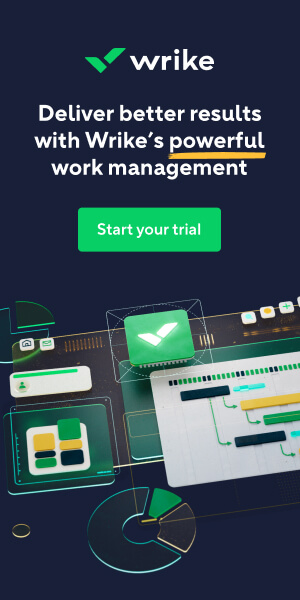If you are a project manager, then you are aware of blockers. Projects with a lot of moving parts need to be constantly pushed forward. Blockers are those inevitable and frustrating things that present themselves at the most inopportune times, literally blocking the progress of a task or effort. This article focuses on the different types of blockers you may encounter, with examples and suggestions on how to minimize their impact.
What Is a Blocker?
A project blocker is anything that completely prevents progress from occurring within a project. A blocker can be a person or a thing, and can be internal or external. They are show-stopping and require immediate attention to resolve. Luckily, blockers are also almost always predictable. Every project has dependencies or tasks that have to happen before others; blockers prevent these tasks from being completed.
Impediments, which are different from blockers and less severe, can also occur. Often called bottlenecks or constraints, they limit progress, but do not entirely stop it.
Read more: Best Project Management Software for 2021
People Blockers
A person or group of people can bring progress on a project to an abrupt halt. Have you ever kicked off a project, only to have a new person take over or join late? This individual has to be brought up to speed, which can add days or weeks of time. Depending on their role, the whole project may have to be put on hold until they are capable of picking up where the last person left off.
You can’t always avoid people blockers, as teams tend to grow and change with companies. The best course of action is to reel the new person in as soon as you can and give them a mini-kick off to bring them up to speed quickly. From there, you should support them as they integrate with the team and role.
Dependency Blockers
Dependencies, or things that need to occur before or immediately after a task or workstream, need special attention. A new brand created by an outside agency that requires approval before the website your team is building can launch — that’s an example of a dependency. Say the agency project manager gives you their timeline, but it begins to slip for reasons unknown. What you thought would be done by June is now pushing into mid-July, adding weeks to your effort.
This situation can be predictable, but it’s not always avoidable. Constant communication with the vendor team lead or PM is necessary to understand where they are with their efforts, and what is left. When a dependency blocker arises, you should reprioritize your project plan and identify things you can begin work on now. That way, your team is prepared for when the project can officially move forward.
Feedback Loop Blockers
There is no better feeling than handing off a deliverable for review and feedback, especially when it is on time. Whether it’s going to an internal executive, a vendor, or a client, there is a sense of accomplishment in completing a draft or final version and anticipating constructive comments or a thumbs up. You craft the email, hit send, and fully anticipate a response by the date indicated. In a perfect world, yes, this can happen. In the world of a project manager, it’s not likely.
A feedback loop blocker occurs when a reviewer keeps asking for more and more changes to a deliverable, halting project progress. There are several ways to minimize feedback loop blockers.
- Set up a feedback meeting. Instead of sending things off into oblivion and hoping for the best, you can schedule a call with the reviewer to walk them through the deliverable with a request to look it over beforehand and to come prepared with questions. This way you can record the bulk of their feedback in one session, and any outstanding questions can be answered shortly thereafter while you begin implementing the changes.
- Consolidate feedback. If there is more than one reviewer, ask for feedback from them individually with a clear deadline. Then schedule a group call to review the consolidated feedback.
- Use a collaboration tool. You can use a tool like Workfront for design or visual deliverables, or a simple one like Google Docs or PowerPoint for text-based items. You want to see changes and comments that include timestamps and notification options, so you know as soon as the review takes place.
- Get a timeline. For more regulated reviews with associations or legal, it is helpful to ask for their review calendar. Coordinate according to their schedule, and build that into your timeline.
Time Blockers
Time can be a project friend or a foe. Give your team too much time to do something and they might keep extending it out. Give them too little time, and they might keep extending it out. Creative tasks like designs are a good example of something that can go on and on.
The project timeline is a guide and a tool to keep things moving and your team accountable. Push back as they might, it’s important that they stick to the agreed upon deadlines before a few hours’ or days’ delay spirals out of control. Any number of reasons may come up for not following the timeline, from competing, higher priority work to poor time estimates across tasks. Frequent check-ins provide an opportunity to keep a finger on the pulse of progress. Learn your team members’ strengths, weaknesses, and habits, and you will be able to find the most effective timeline for tasks. Remember: Everyone wants to be successful in their work, and not everyone works in the same way.
Read more: How to Use Different Project Timeline Templates
Communication Blockers
We have all heard communication is key. There has never been a more true statement when it comes to running a successful project. Communicating the right information to the right people is a puzzle the project manager has to decipher early on. When projects get technical or complicated with overlapping workstreams, and deliverables are dependent on multiple factors, it can feel like a juggling act. With many teams working remotely now, details can get lost or miscommunicated and lead to vague requirements, wreaking exponential havoc later on.
Here’s four tips for heading off communication blockers:
- Write it down. Detailing questions, answers, and action items in an email or other written format that spells out exactly what is being asked for.
- Get a second opinion. Double-check specifics with team leads and subject matter experts before sending a complex communication to ensure it is error-free and clear.
- Get confirmation. When you receive a request, follow up with a quick phone call or instant message to confirm you understand it.
- Open the floor. Before you end a meeting, ask if anyone has questions or needs clarification.
Technical Blockers
Projects that involve development often get blocked by technical issues with code or during testing. Depending on the size and expertise of the development team, technical issues can be expected, but sometimes they are a surprise. Either can be costly in time and money. Examples include new technology, blackout periods, hardware malfunctions, server crashes, bugs, and environmental issues. Try to predict what these could be and plan for them in advance of the work.
There are processes you can use to minimize the impact of these blockers.
- Build a prototype that includes a sampling of functionality.
- Schedule time for multiple releases and reviews.
- Follow an agile process and include just a few features in a sprint that can be built and tested quickly, then built upon.
- Schedule a mock run for a larger release and walk through it in a test environment prior to the go live event.
How to Handle Team Bandwidth
Team bandwidth is arguably one of the most common blockers to a project’s progress. Work can come in waves with downtime in between. Something might go on hold, freeing up time for other projects. And then it comes back, and one or more team members are over capacity again. There are really two options here: bring on more people to help, or keep the team as-is.
Bringing another person to the team mid-project creates a new challenge for project managers.
Pros: This person can help divide and conquer the workload. The lost time can be made up, and now you have backup experience.
Cons: A new person needs time to ramp up, and now you are managing two people through one task or workstream — which takes up more of your time. There is no guarantee this will make things quicker and easier. Also, there is budget impact when you double the role. Further, the new person’s work may not look, read, or function the same as the other person’s. And they may work at different speeds on the same thing.
Keeping the team as-is will require some action on the project manager to navigate this tricky blocker of their time.
Pros: You can communicate the time issue to management and see if there is leeway. Request a list of projects to see where your project falls in terms of resources. Also, there are time entry tools like Harvest that require team members to log hours against a budget plan. This will engage them to manage their time with a goal of not exceeding estimated hours. This works especially well in small business, where budgets are tight and every hour and dollar are tracked.
Cons: You will continue to juggle the team’s time, but this may be the best solution for budget. Sometimes, they may not be able to deliver on the schedule and budget, and a change order may be required.
How to Handle Overworked Teams
You may be dealing with an entire team that is overworked and falling short. Depending on the pace of work communicated by stakeholders, you could inherit a team that doesn’t get a break between projects, or has multiple high-priority commitments going on at the same time. Project managers don’t usually have a say in these matters and are expected to work with what they get. An overworked team can threaten project progress with multiple blocker opportunities if you don’t plan well for this scenario. Over time, this can lead to burnout and then you have a more serious issue to address.
Symptoms of overworked individuals:
- It is difficult to book time with them because calendars are full.
- They come to meetings unprepared.
- They express frustration at having to switch focus so often.
- They are distracted by instant messages and email during meetings.
- They arrive late to meetings, cut out early, or miss them entirely.
Best practice when dealing with overworked teams is to make the environment of your project as efficient and productive as possible.
- Limit meetings to 30 minutes, and only invite those that must attend.
- Confirm and understand the priority of the project in comparison to others.
- tasks frequently to understand what is needed and when.
- Track time with tools you can pull reports on.
- Divide up tasks so the team can use time effectively.
- Identify tasks or projects that can be postponed.
- Say no to things that just aren’t needed.
All project managers wrestle with the constraint of scope, time, and cost to produce a quality product or service. The successful completion of a project requires a project manager to keep track of all blockers, constraints, bottlenecks and dependencies, and reallocate resources as needed until the end of the project.
Read next: 2021 Guide to Becoming a Project Manager












